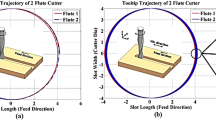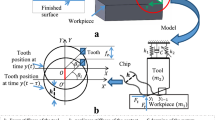Abstract
Self-excited vibration (chatter) is determined by the relation between the vibrating system and the cutting process. In current theories, the dynamic cutting force model in a form suggested by Tlusty and Polacek in the 1950s is still used. However, this model oversimplifies the dynamic cutting process by trying to express all processes using a single cutting force coefficient. Measurement results presented in this article clearly show that such simplification of the cutting process is unacceptable. This work follows upon the original measurement method by Tlusty and Polacek using controlled tool vibration. The method was intended to research the cutting process dynamics. However, the original Tlusty and Polacek method ignored the impact of the length of the workpiece surface wave. The original method is innovatively developed by taking into account the impact of the chatter frequency. The new method allows to better understand the processes occurring during dynamic cutting. As opposed to the original method, current advanced measurement equipment allows for more precise examination of the cutting process in dependence on the chatter frequency. The article shows that results obtained by the new method can be utilized for modeling the cutting force with greater precision in order to better predict the cutting process stability.























Similar content being viewed by others
References
Altintas Y (2012) Manufacturing automation: metal cutting mechanics, machine tool vibrations, and CNC design, 2nd edition, Cambridge University press, 2012, New York. ISBN 978-1-107-00148-0
Cheng K (2008) Machining dynamics: fundamentals, applications and practices. Springer, London ISBN 978-1-84628-367-3
Tlusty J, Polacek M (1963) The stability of the machine tool against self-excited vibration in machining. ASME Int Res Prod Eng:465–474
Tlusty J (1978) Analysis of the state of research in cutting dynamics. Ann CIRP 27:583–589
Goel B (1976) Measurement of dynamic cutting force coefficients. Dissertation, McMaster University. https://macsphere.mcmaster.ca/handle/11375/8095>. Accessed 18 June 2014
Rao SB (1977) Analysis of the dynamic cutting force coefficient. Dissertation McMaster University. https://macsphere.mcmaster.ca/handle/11375/8826>. Accessed 18 June2014
Nigm MM, Sadek MM (1977) Experimental investigation of the characteristic of dynamic cutting process. ASME J Eng Ind 99:410–418. https://doi.org/10.1115/1.3439252
Heczko O (1980) New method for testing the dynamic cutting force coefficients. Dissertation, McMaster University. https://macsphere.mcmaster.ca/handle/11375/17929. Accessed 19 August 2015
Ahn TY, Eman KF, Wu SM (1985) Identification of the transfer function of dynamic cutting processes – a comparative assessment. Elsevier Int J Mach Tool Des Res 25:75–90. https://doi.org/10.1016/0020-7357(85)90059-9
Minis IE, Magrab EB, Pandelidis IO (1990) Improved methods for the prediction of chatter in turning, part 2: determination of cutting process parameters. ASME J Eng Ind 112:21–27. https://doi.org/10.1115/1.2899291
Insperger T, Stepan G (2011) Semi-discretization for time-delay systems: stability and engineering applications. Springer, New York ISBN 978-1-4614-0334-0
Wu DW, Liu CR (1985) An analytical model for cutting dynamics. Part 1: model building. ASME J Eng Ind 107:107–111. https://doi.org/10.1115/1.3185972
Altintas Y, Eynian M, Onozuka H (2008) Identification of dynamic cutting force coefficients and chatter stability with process damping. CIRP Ann Manuf Technol 57:371–374. https://doi.org/10.1016/j.cirp.2008.03.048
Budak E, Tunc LT (2010) Identification and modeling of process damping in turning and milling using a new approach. CIRP Ann 59:403–408. https://doi.org/10.1016/j.cirp.2010.03.078
Xiao W et al (2014) A method of using turning process excitation to determine dynamic cutting coefficients. Elsevier Int J Mach Tools Manuf 87:49–60. https://doi.org/10.1016/j.ijmachtools.2014.08.002
Sniegulska-Gradzka D, Nejman M, Jemielniak K (2017) Cutting force coefficients determination using vibratory cutting. Procedia CIRP 62:205–208. https://doi.org/10.1016/j.procir.2016.06.091
Bach P, Polacek M, Chvojka P, Drobilek J, Svoboda O (2013) A comparative analysis of lower speed chatter behaviour. MM Sci J 2013:434–440. http://www.mmscience.eu/content/www_mmscience_cz_201314(1).pdf. Accessed 7 Jan 2014
Nigm MM, Sadek MM, Tobias SA (1977) Dimensional analysis of the steady state orthogonal cutting process. Elsevier Int J Mach Tool Des Res 17:1–18. https://doi.org/10.1016/0020-7357(77)90023-3
Munoa J, al e (2016) Chatter suppression techniques in metal cutting. CIRP Ann 65:785–808. https://doi.org/10.1016/j.cirp.2016.06.004
Peters J, Vanherck P, Van Brussel H (1971) The measurement of the dynamic cutting coefficient. Elsevier CIRP Ann Manuf Technol 21:129–136
Acknowledgements
The research was supported by the Technology Agency of the Czech Republic from the funds earmarked for the TE01020075 Competence Centre project.
Author information
Authors and Affiliations
Corresponding author
Additional information
Publisher’s note
Springer Nature remains neutral with regard to jurisdictional claims in published maps and institutional affiliations.
Rights and permissions
About this article
Cite this article
Drobilek, J., Polacek, M., Bach, P. et al. Improved dynamic cutting force model with complex coefficients at orthogonal turning. Int J Adv Manuf Technol 103, 2691–2705 (2019). https://doi.org/10.1007/s00170-019-03715-0
Received:
Accepted:
Published:
Issue Date:
DOI: https://doi.org/10.1007/s00170-019-03715-0




